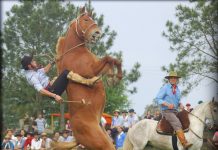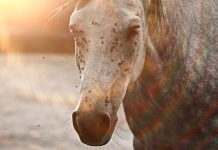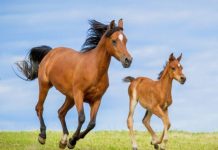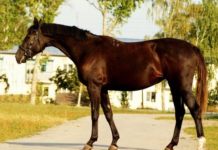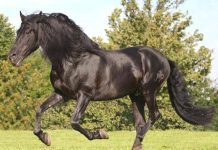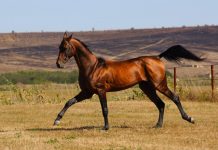The New Forest pony is very easy to ride, has a very attractive appearance, and usually has a really great character.
Because the medium-sized New Forest pony is a popular recreational horse for children and adults, it is also bred and offered in sufficient quantities.
If you’re looking for a pony, this article about the New Forest pony is right for you.
Breed description

The New Forest Pony is an expressive, talented, and also simply very pretty pony with a very pleasant nature.
It has the genes of sturdy original ponies, but also the genes of noble thoroughbreds and fiery Arabs – a great mix that is justifiably very popular.
The New Forest Pony is also a riding pony with a lot of talent in all disciplines, it can jump and dressage and is also happy to accompany you on rides.
It is also well suited for driving, for children, teenagers, and adults – even beginners can usually get along very well with the friendly and reliable New Forest pony.
With the New Forest Pony, ambitious riders will find a partner with beautiful movements and a lot of jumping ability, who can enable considerable sporting success.
Origin and breed history
The ponies from which the New Forest pony was bred ran around in the forests of the British county of Hampshire on the south coast of England as early as the 11th century, and they were mentioned in a document as early as 1016.
It is from these forests that they get their name: The New Forest is the name of the landscape in the south of England where the ponies are native.
There is ancient forest, heather, and pasture there, now the New Forest stretches across south-west Hampshire and parts of south Wiltshire and east Dorset.
The heather and moor ponies initially crossed themselves with horses of different races by themselves, but the residents also mated them with thoroughbreds and Arabs. B. came to the region in the course of the crusades in the 12th century.
So the original ponies became more and more elegant and bigger. At the beginning of the 20th century, the first associations for the targeted breeding of New Forest ponies were founded. These included the Burley & District New Forest Pony Breeding & Cattle Society, which published the first stud book in 1910.
However, it had still allowed stallions of very different breeds to be bred, and it was only from around 1935 that attention was paid to keeping foreign blood out of the breeding program.
The history of breeding was then recorded by the British National Pony Society until 1959, until the New Forest Pony Breeding & Cattle Society’s studbook, which is still valid today, was published in 1960.
The New Forest Pony is now being bred by the British Breeding Association as a pure breed. The first New Forest ponies were exported to Germany as early as the 1960s.
The New Forest Pony breed was primarily bred in stud farms in Schleswig-Holstein, the Weser-Ems-Land and in Bavaria. The New Forest Pony has meanwhile made itself popular in many other German regions.
All breeders’ associations formed in Germany that breed the New Forest Pony within the framework of the German Equestrian Association must adhere to the breeding standards of the British New Forest Pony Breeding & Cattle Society.
The appearance of the New Forest pony
The New Forest pony is a pony with strong legs and a well-muscled and well-angled hindquarters. The chest is oval and massive, the withers well developed.
The long, sloping shoulders merge into a firm, strong back and a muscular croup, the New Forest Pony offers a good “belt depth” (roughly equivalent to the chest circumference) for the saddle.
The rather long neck is slightly curved and offers a lot of freedom of gait, which is important for riders. The ganache is the jaw, the rear part of the lower jaw, which, if the ganache is clear, shows a sufficient distance to the wing of the first cervical vertebra that begins behind the ear, so that the horse can walk straight up “on the rein”.
The slim but strong legs show straight bones, clearly formed and healthy joints, and hard, perfectly formed hooves. What has just been described is a pretty optimal riding pony.
Most fans, however, are sure to win the New Forest Pony with its beautiful head: medium-sized and noble, with a straight to concave nose line and broad forehead, it is remarkably well-formed.
In addition, there are large eyes typical of the breed with a clear look, which makes the New Forest Pony appear reliable and balanced, but also gives it an “almost irresistible” expression.
The coat colors of the New Forest pony are very varied: Except for “exotic” horses such as (tiger) piebalds, all normal horse colors occur. To keep it that way, light-colored foxes with dark eyes and palominos in all shades are not permitted as sires for genetic reasons.
White markings on the head and legs do occur but are only desirable if they are limited to parts of the face and legs.
Actually, the New Forest pony is bred in two types:
The normal New Forest Pony with an average height of 143 cm, which should not be taller than a maximum of 148 cm.
A mini version of the New Forest pony that only grows to about 122 cm.
The mini version of the New Forest pony has become very rare today because the larger type of riding pony is much more in demand.
Temperament and essence
If primitive ponies mix or are mixed with all sorts of other horse breeds over a long period of time, this results in great genetic diversity.
This is known to be important for physical health, but according to recent research, it also seems to have a lot more to do with “head clarity” than most people realize.
In any case, the colorful and diverse history of the breed has had a positive effect on the New Forest pony: it typically shows a balanced and calm temperament, is known to be good-natured and uncomplicated.
In addition, as brave and reliable, intelligent and docile – the New Forest pony is usually valued by its owners as a leisure and sports partner.
Husbandry and nutrition
Attitude
The New Forest Pony is easy to hold in that the usual average box offers enough freedom of movement for its size.
In other respects, a New Forest pony is not so easy to keep: The intelligent New Forest pony needs a lot of stimulation and activity and also wants to have a lot of contact with other horses.
Although this has long been part of the normal requirements for species-appropriate horse keeping, it is by no means implemented for every horse’s life.
If a stable is in a rural area where the New Forest pony is regularly ridden in the great outdoors and also regularly goes to pasture, where it can move around a lot with other horses or ponies, it will probably be comfortable.
If this cannot be guaranteed, you can look for an active stable. Alternatively, you can use your New Forest pony to the full in the daily work with fairly demanding training and also keep it busy on the side.
Since many horse owners, today are aware of how much activity and exercise horses and ponies need for a happy life, new products are constantly being developed to keep horses busy.
Inquire about toys for horses and try feeding retarders like this hay net.
It is also becoming more and more natural to have an otherwise underemployed horse looked after by several people.
Nutrition
A New Forest pony has the genes of ponies that ran around on inhospitable moorland and heather where the food was anything but princely.
It, therefore, does not make any special demands on its diet. Give your New Forest pony good, healthy food, if possible from organic farming.
A lot of roughage like hay, straw, herbs, often and often juice feed like carrots, apples, beetroot and definitely not too much-concentrated feed like oats or barley.
You should calculate the need for concentrated feed with your feed master and quickly adapt it to your daily performance, because too much concentrated feed can cause metabolic diseases quite quickly.
The only danger is that your New Forest pony will become fat if it is underutilized or under-challenged.
You should always remain sensitive in this direction, because the energy requirement of ponies is often estimated to be higher than it actually is.
Education and care

Upbringing
A New Forest pony is usually very well behaved around the stable, almost on its own. It may take a little getting used to, in which you show him everything with a lot of patience and a lot of time.
But the actual upbringing that the New Forest pony receives as a foal from the breeder is usually stuck for a lifetime in the affable New Forest pony.
The equestrian training of a New Forest pony, on the other hand, is quite demanding because the New Forest pony usually has a lot of talent.
A very versatile talent: With its expressive appearance and friendly nature, the New Forest pony can be trained very well to become a riding pony.
In recreational riding, he has enough talent for all disciplines. A New Forest pony likes to jump even under inexperienced riders if the height of the obstacles remains within limits, brings nice gears for dressage tasks, and is very popular.
Not only is it a pony for kids, but the normal, larger type can be ridden by teens and even light adults.
The pronounced talent for movement and jumping ability even make considerable sporting success possible among good riders, if these good riders are supervised by a good instructor.
Maintenance
The New Forest pony is fairly easy to care for. The shiny fur of the New Forest pony invites you to groom and is also very easy to groom.
The small hooves can be scratched out very well, and of course, you should generally make sure that all parts of your pony’s body look good and are clean.
The mane and tail need to be untangled on occasion, eyes and ears cleaned when necessary, but that was, by and large, about caring for this no-nonsense pony.
Health and Typical Diseases
The frequent development of sweet itch was a problem for the New Forest pony for a while.
Today, New Forest ponies that have shown signs of this allergic skin disease are no longer permitted for breeding.
Otherwise, the New Forest Pony is a healthy breed of horse with straight bones and healthy hooves that is carefully bred to be healthy.
With a lot of exercise and activity, a healthy, species-appropriate diet, and careful care, you can do a lot to ensure that it stays that way.
Life expectancy
The life expectancy of horses is in the large range between around 25 and more than 50 years. There are differences between the large groups of horses and the individual horse breeds.
The New Forest pony has “good cards” in every respect: It is a pony and therefore ripe late, which already contributes to the extension of life expectancy.
It belongs to a healthy breed, and it has ancestors who were struggling to survive. The New Forest Pony, which is quite robust despite all its elegance, still draws heavily on this legacy and can live up to 35 years.
The prerequisite is of course that you do everything with good posture to ensure that your New Forest Pony is always doing well.
Eat them well, move them around a lot and keep them busy, even outside of the common rides, and in a way that a New Forest pony has fun (except for the ability to find the necessary time, not difficult, a New Forest pony has a lot of fun ).
Buy New Forest Pony horse breed
If you want to buy a New Forest Pony, you can contact the New Forest Pony Breeding & Cattle Society directly.
You can also search for a New Forest pony on horse market platforms on the Internet (or in real horse markets, if there are any in your area) and in classified ads.
Or ask stable mates whether they know someone who wants to hand in a New Forest pony or ask at collection points for orphaned horses/ponies.
Because the New Forest pony is popular and widespread, and there are always people who, for all sorts of reasons, have to part with their beloved New Forest pony.
Wouldn’t it be nice if such a New Forest pony found a nice new home with you?
Decision support

If you are sure that you really want to have a horse as a pet, the New Forest Pony is a good choice, especially as the first horse.
It’s just not stubborn, mostly friendly, and in a good mood. If you still waver between dog and horse because a horse is currently a little too expensive in terms of time and money, there is a very elegant solution.
First, the dog comes and you can then work with him to be surrounded by dogs and New Forest ponies in a few years.
Among the many great dog breeds, a number of them are very suitable as future buddies of a pony.
If you get a dog from the animal shelter, the staff can sometimes even find you dogs that were raised with horses.
But actually, every dog that can keep up with the ride can get used to handling a horse with a little empathy.
For good riders with sporting ambitions, the New Forest Pony may be the beginning of a real tournament career (although it is said that its appearance alone can delight some judges).
The New Forest pony is also a good family pony, which with its frugality and balanced temperament is sure to be quickly taken in the hearts of all family members.








